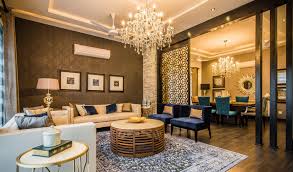Karachi is a city of layers: heritage homes, modern high-rises, retail centres, boutique cafés, and industrial zones. With such diversity, interior design isn’t just about aesthetics—it’s about translating lifestyle, purpose and atmosphere into the built environment.
- Adaptability & context: A designer in Karachi must respond to local climate (heat, humidity), structural realities (older buildings, smaller spaces) and cultural nuances (e.g., hospitality areas, extended family living).
- Function meets form: Whether it’s a residential apartment or a corporate boardroom, the space must not just look good—it must work. Effective space planning, circulation, lighting, and flow are vital.
- Quality & durability: With local availability of materials and labour variability, a top designer will ensure details are robust, finishes are smart, and execution is reliable.
- Identity & style: Today’s clients often want their space to reflect their personality or brand—minimal-modern, classic elegance, transitional fusion, or perhaps local craftsmanship with a modern twist.
- Value addition: Good interior design can enhance the perceived value of a property, improve comfort, and increase usage efficiency—so it’s not just cost, but investment.
In short, choosing an interior design partner in Karachi means selecting someone who understands the local and global, the aesthetic and functional, the budget-wise and ambitious.
What distinguishes a “top” interior designer in Karachi
When you evaluate potential interior designers in Karachi, here are key attributes to look for:
- Portfolio breadth and relevance – A strong sample of completed projects in the specific category you need (residential, commercial, retail) showcases versatility and craftsmanship.
- Client-centric process – From initial consultation through design development, procurement, and installation, you want a designer who listens, adapts and communicates clearly.
- Technical competence – Skills in space planning, 3D visualisation, materials & finishes, lighting design, and execution supervision matter. A designer who merely picks colours and furniture may fall short.
- Local sourcing & network – Relationships with reputable fabricators, contractors, vendors in Karachi ensure smoother execution, better pricing and reliable timelines.
- Transparency & budget-control – Clear scope, realistic timelines, breakdown of costs and alternate options help you manage finances and avoid surprises.
- Post-occupancy support – Good designers will check back, fine-tune details, and ensure your space functions as planned once you move in.
In essence: the best interior designers in Karachi don’t just deliver “pretty pictures”—they deliver functional, built-out spaces, on time and on budget.
Snapshot of the interior design landscape in Karachi
The market in Karachi is rich with options—from small freelance practitioners doing boutique homes, to full-service design studios handling luxury villas or corporate fit-outs. According to industry data: there were over 1,700 interior-design firms across Pakistan in recent years, with a significant concentration in Sindh and Karachi being a major hub. Rentech Digital+1
Some of the recent listings and directories mention interior-designers in Karachi who have built reputable standings. For example: a blog from Graana.com outlines several names described as “top interior designers in Karachi” diversified across home, office, and retail projects. Graana.com Likewise, companies like Dream Interior (promoting luxury interior design) highlight a structured process from consultation to execution. dreaminterior.pk
One firm, Designing Hub, describes itself as offering architectural and interior solutions in Karachi covering offices, cafés, salons, residential spaces, and emphasises client-satisfaction and timely delivery. Designing Hub
What this tells us:
- There is no shortage of talent in Karachi.
- Many firms claim ability to handle full-scale projects (design + build).
- You’ll find firms that emphasise luxury, those that emphasise cost-effectiveness, and others that occupy niches (retail, hospitality, custom furniture).
- Because of competition, you have leverage—but also need to do your homework.
Tips for selecting your interior designer in Karachi
Here are some practical steps you can follow to ensure you select the right designer and avoid common pitfalls:
A. Define your brief and budget
Before contacting designers, be clear (or as clear as possible) on:
- The type of space (residential, office, retail) and approximate size.
- Functional requirements: how many rooms, what uses, special features (e.g., home-office, media room, display area).
- Style preferences: modern, minimal, classic, industrial, eclectic. Bring images or references.
- Rough budget and timeline. Communicate upfront to see if the designer is aligned.
B. Shortlist and meet at least 2–3 designers
- Request portfolios of relevant projects (size, type & style).
- Ask for client references or testimonials.
- Visit one of their completed projects if possible, or view live photos.
- Ask about their process: conceptual design → detailed drawings → procurement → execution → handover.
- Inquire who manages the project onsite: the designer themselves, a project manager, or a contractor?
C. Evaluate the contract & deliverables
- Ask for a written scope: what is included (drawings, sourcing, furniture, supervision) and what is not.
- Ask for timelines and milestones.
- Clarify procurement norms: will you purchase through the designer’s vendor network, or will you engage separately? How is markup handled?
- Payment schedule: ideally tied to milestones (design completion, procurement, installation).
- Change-order process: how will additional costs or changes be handled?
D. Monitor quality and progress
Once the work begins:
- Regular site meetings and updates matter—make sure you’re kept in the loop.
- Check materials, finishes and workmanship. Don’t assume everything will be perfect without oversight.
- Allow for realistic buffer—especially in Karachi there may be lead-time on custom furniture, imported finishes or permit-related delays.
- When complete, walk through with the designer; check every detail, from lighting switches to cabinet finishes and operational elements.
E. Post-handover check
- Ideally, the designer should provide a punch-list that is addressed.
- Ask about after-service: minor tweaks, warranty on custom furniture or built-ins.
- Enjoy your space—and capture how well it meets your usage, comfort and aesthetics.


Leave a reply